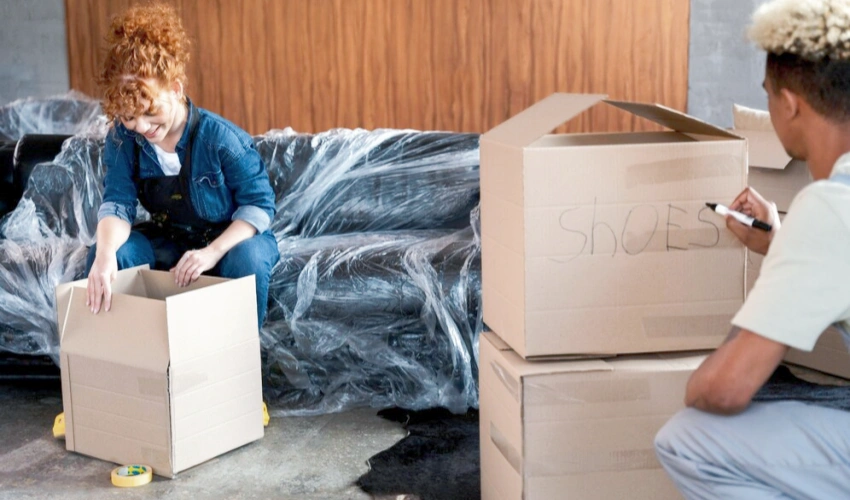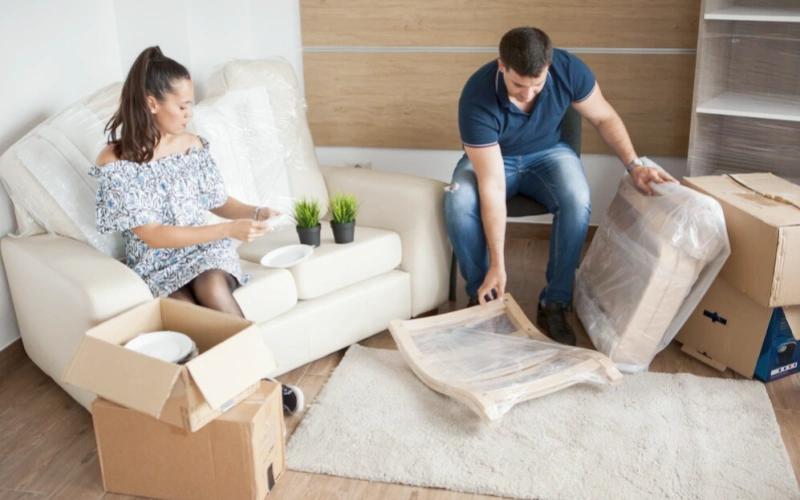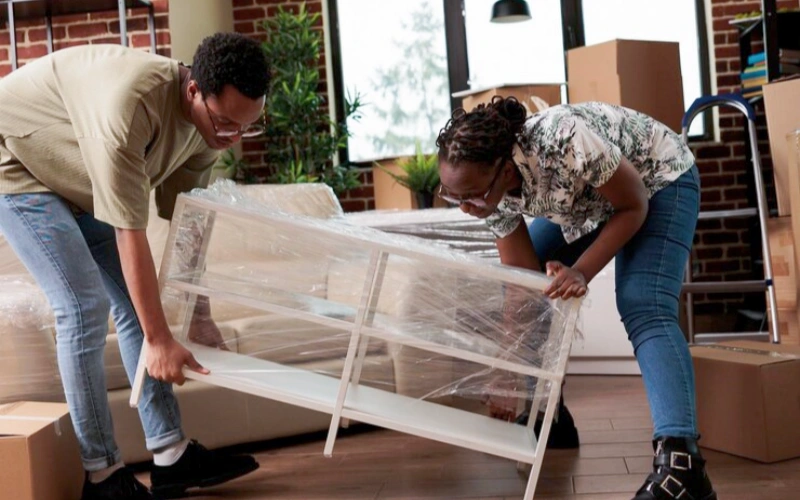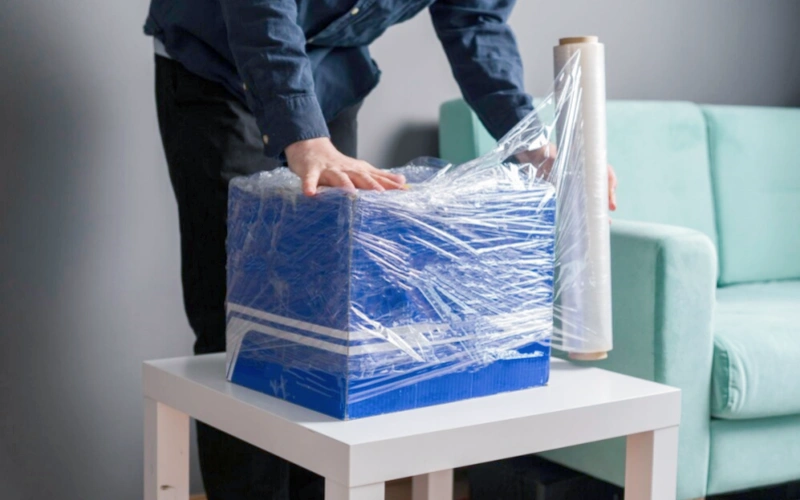
Picture this: Your prized wooden desk arrives at your new home with a deep scratch from the truck, or your sofa’s fabric reeks of mildew after a rainy move. Sadly, this nightmare is reality for 70% of movers—but it doesn’t have to be yours.
Enter plastic cling wrap for moving, the unsung hero of hassle-free relocations. Unlike flimsy kitchen-grade wraps, these heavy-duty rolls are engineered to lock drawers, armor furniture edges, and seal out dust and moisture. They’re thinner than bubble wrap yet 3x cheaper, and they vanish after unwrapping—no sticky residue, no waste.
Pro movers swear by industrial-grade plastic cling wrap furniture protection for securing everything from marble countertops to fragile heirlooms. Now, eco-conscious homeowners can join the trend too: Biodegradable options let you protect your furniture and the planet.
Ready to turn packing chaos into a well-oiled operation? Discover how the right plastic cling film wrap for movin (spoiler: not all wraps are created equal!) can save your sanity—and your savings—one roll at a time.
All three packing materials aim to shield furniture and household goods from the bumps, jolts and moisture of a move, yet they differ sharply in price, protection profile, convenience, and environmental impact. The quick reference table below sets the stage; the deeper dive that follows explains why those numbers matter when you are trying to save both money and headaches.
| Criteria | Moving Wrap | Bubble Wrap | Moving Blankets | Winner |
|---|---|---|---|---|
| Cost per Use | 0.08–0.12/sq ft | 0.25–0.35/sq ft | 40–80/day (rental) | ✅ Moving Wrap |
| Scratch Protection | ⭐⭐⭐⭐ (3+ layers required) | ⭐⭐⭐⭐⭐ (built-in cushion) | ⭐⭐ (surface-only) | ✅ Bubble Wrap |
| Water Resistance | ⭐⭐⭐⭐⭐ (fully waterproof) | ⭐⭐ (absorbs moisture) | ⭐ (traps humidity) | ✅ Moving Wrap |
| Eco-Friendliness | ⭐⭐⭐ (biodegradable options) | ⭐ (non-recyclable) | ⭐⭐⭐⭐ (reusable) | ✅ Moving Blankets |
| Ease of Use | ⭐⭐⭐⭐ (no tools needed) | ⭐⭐ (requires tape) | ⭐⭐⭐ (heavy to move) | ✅ Moving Wrap |
| Best For | Moisture-prone items, securing loose parts, irregular shapes | Fragile items, electronics | Short-distance moves, floor protection | Scenario-dependent |
Film rolls store upright in a closet and add virtually no weight. Bubble wrap is light but voluminous before it is used. Twelve folded blankets consume 4 – 6 cu ft of cargo space and add 30 lb when wet—space you could fill with boxes instead.
| Scenario | Recommended Material |
|---|---|
| Protecting hardwood tables and upholstered chairs from rain & scratches | Moving Wrap |
| Cushioning delicate ceramics or electronics against drops | Bubble Wrap around the item + Moving Wrap to bundle |
| Stacking appliances in a freight van where friction is key | Moving Blankets plus ratchet straps |
| Long-term storage in humid garage or basement | Moving Wrap (vapor seal) |
For the average household move, heavy-duty moving wrap delivers the lowest cost-per-square-foot, the fastest application, and the broadest protection spectrum. Reserve bubble wrap for small fragile items, and rent blankets only when you have large appliances that need friction padding or plan to reuse them multiple times within the same rental period. When you tally direct costs and hidden expenses like time, truck space, and potential water damage, moving wrap usually wins the value equation hands-down.
Stretch wrap (cling film) is one of the most versatile and underrated tools for moving. Unlike tape or ropes, it offers unique advantages that streamline packing, protect belongings, and reduce stress. Here’s why it’s a must-have for your next move.
Stretch wrap is the ultimate multitasker for moving—it’s a protector, organizer, and space-saver in one. By securing loose parts, shielding surfaces, and simplifying logistics, it turns a chaotic move into a well-oiled operation.

Problem: Drawers sliding open, scratches on wooden surfaces.
Solution:
Pro Tip:
Problem: Stains, moisture damage, and fabric tears.
Solution:
Pro Tip:
Product Pick: Best heavy duty cling wrap for moving furniture-PWP Stretch Film Brand Heavy Duty Wrap – stretchable, non-slip grip.
Problem: Shattering from vibrations or impact.
Solution:
Pro Tip:
Problem: Scratches, humidity warping, and veneer peeling.
Solution:
Pro Tip:
Eco Pick: PWP Stretch Film Biodegradable Wrap – safe for untreated wood.

Problem: Stains, moisture, and bed bug transfer.
Solution:
Pro Tip:
Problem: Dust in vents, water damage, and loose cords.
Solution:
Pro Tip:
Problem: Fragile parts, tangled cords, and dust accumulation.
Solution:
Pro Tip:
Problem: Adhesive residue, frame scratches.
Solution:
Pro Tip:
| Furniture Type | Best Cling Wrap | Why Buy? |
|---|---|---|
| Heavy Wood | PWP Stretch Film High-Hold (3μm) | Lab-tested 18N tensile strength |
| Electronics | PWP Stretch Film Brand VCI Stretch Film | Anti-static, protects sensitive parts |
| Eco-Conscious | PWP Stretch Film Biodegradable stretch film | BPI-certified, decomposes in 6 months |
Problem: Shampoo, cleaners, or paint cans leaking during transit, ruining boxes.
Solution:
Problem: Dirty shoe soles staining clothes in suitcases.
Hack:
Problem: Plants, tissue boxes, or tools sliding around in your car.
Fix:
Problem: Dust settling on furniture during pre-move renovations.
Hack:
Problem: Losing screws and bolts when disassembling furniture.
Fix:

Packing Tips for Using Cling Wrap to Protect Furniture During a Move
Moving furniture is like playing a high-stakes game of Tetris—every piece needs to fit perfectly and survive the journey. Cling wrap isn’t just for leftovers; it’s a secret weapon for safeguarding your furniture. Here’s how to use it creatively and effectively, with pro tips to avoid damage and streamline your move.
Clean Surfaces: Wipe down furniture to remove dust or grease—cling wrap adheres better to clean surfaces.
Disassemble What You Can: Remove legs, shelves, or cushions. Wrap them separately to avoid pressure points.
Protect Delicate Finishes: For polished wood or leather, place a layer of soft cloth or paper under the cling wrap to prevent adhesive marks.
Cling wrap’s flexibility and grip turn chaotic furniture into compact, tamper-proof units. Pair it with smart prep and creative techniques, and you’ll arrive at your new home with furniture that looks as good as the day you bought it.
Moving can be a stressful process, but using the right tools—like cling wrap—can streamline packing, protect belongings, and save time. However, not all cling wraps are created equal. Here’s a detailed, original guide to selecting and using cling wrap effectively for your next move.
Cling film for wrapping furniture falls into two main categories:
Pro Tip: For most moves, combine both types. Use PE for lightweight tasks and PVC for bulky furniture.
Not all cling wrap is optimized for moving. Look for these features:
Upgrade efficiency with these niche options:
Maximize cling wrap’s potential with these accessories:
Even the best plastic wrap for moving won’t help if applied poorly. Follow these steps:
Choosing the right cling wrap isn’t just about sticking items together—it’s about optimizing protection, speed, and cost. By matching wrap types to your needs, using smart techniques, and pairing with complementary tools, you’ll turn a chaotic move into an efficient, stress-free process.
Yes, cling wrap can be highly effective for moving. It is especially useful for securing furniture and other belongings during the transportation process. Cling wrap for moving provides a protective layer that shields your items from dust, dirt, and scratches. It is commonly used to wrap furniture, keeping doors, drawers, and other loose parts tightly in place. Additionally, cling wrap can help secure small parts, like screws or bolts, by bundling them together with the furniture or appliance they belong to. It’s important to use the right type of cling wrap for moving, such as heavy-duty cling wrap, which is thicker and more resistant to tears, making it ideal for protecting larger items like sofas, tables, and mattresses. Cling wrap is not suitable for padding, so you should combine it with bubble wrap or blankets for better protection when wrapping delicate or fragile items.
Cling film and cling wrap are terms often used interchangeably, but there are slight differences in how they are typically used. Cling wrap generally refers to the plastic film used for packing and moving, designed to wrap around furniture and secure loose items during transport. It’s thicker and stronger than household cling film and is commonly found in rolls for easy application. On the other hand, cling film is most often used in kitchens for food storage. It’s a thinner plastic wrap, designed to seal food containers and keep food fresh. Cling film clings easily to itself but is not as durable as cling wrap, and therefore not suitable for heavy-duty applications like moving. When preparing for a move, it’s best to use cling wrap for moving, as it is designed to handle the stresses of transportation and provide better protection for furniture and household items.
Movers wrap furniture in plastic, particularly cling wrap, for several reasons. First, it provides a protective layer that shields furniture from dust, dirt, moisture, and potential scratches during transport. Wrapping furniture in plastic ensures that fabric-covered pieces like sofas and chairs stay clean and dry. Additionally, cling wrap helps secure moving parts, such as drawers, cabinet doors, and shelves, keeping them in place so they don’t open or shift during transit, which could cause damage. It also prevents small components, like screws or detached pieces, from getting lost. In many cases, movers combine plastic wrap with padding materials, such as furniture blankets, to give additional protection, especially for delicate or expensive items. By wrapping furniture tightly in plastic, movers ensure that items are better protected and easier to handle during the moving process, reducing the likelihood of accidents or damage.
Plastic wrap and cling wrap are terms often used interchangeably, but they serve slightly different purposes. Plastic wrap is a broad term for any plastic film used for packaging or protection. Cling wrap, a specific type of plastic wrap, is thinner and designed to cling tightly to surfaces due to static charge or slight tackiness.
In the context of cling wrap for moving, cling wrap is preferred for securing lightweight items or keeping drawers, doors, and loose components in place. Plastic wrap, on the other hand, includes heavierduty wraps like stretch film, which is better for stabilizing bulkier or larger items during transport.
For moving purposes, stretch wrap or moving shrink wrap is often better than cling wrap. Stretch wrap is thicker, more elastic, and provides superior load stability, making it ideal for securing furniture, appliances, or bundled items. It offers better tension and durability, reducing the likelihood of tearing during transport.
While cling wrap is effective for smaller items or securing drawers and doors, stretch wrap is a better choice for heavier or irregularly shaped objects. Additionally, stretch wrap offers weather resistance and protects items from dirt and moisture.
For items requiring cushioning, combining stretch wrap with padding materials like furniture blankets or bubble wrap offers the best protection.
The appropriate gauge of shrink wrap depends on the weight and type of items being moved. For most moving applications, 75 to 90gauge shrink wrap is sufficient.
Lightweight Items: Use 60–75 gauge for securing small or lightweight items like boxes or utensils.
MediumWeight Loads: 80gauge shrink wrap is a versatile option for most furniture, including dressers and chairs.
Heavy Loads: For bulky or heavy items, such as appliances or machinery, 90–120 gauge is recommended for extra durability.
For cling wrap for moving, 80gauge is often preferred, as it balances flexibility and strength.
1. Empty the Dresser: Remove all contents to prevent shifting during transport.
2. Secure Drawers: Use cling wrap to tightly wrap the dresser, keeping drawers shut and preventing movement.
3. Add Padding: For added protection, use furniture pads or blankets around the dresser, securing them with stretch wrap or tape.
4. Wrap Entirely: Cover the entire dresser with stretch wrap to shield it from dust, dirt, and scratches.
5. Protect Corners: Use corner protectors to prevent damage to edges.
Using cling wrap for moving helps keep the dresser secure while minimizing the risk of surface damage.
To keep your mattress clean during a move:
1. Use a Mattress Cover: Purchase a plastic mattress cover to shield it from dirt and moisture.
2. Wrap with Stretch Film or Cling Wrap: Secure the cover with cling wrap to ensure it stays in place during transport.
3. Protect Corners: Use additional padding on corners if the mattress will be maneuvered through tight spaces.
4. Keep It Upright: Transport the mattress in an upright position to minimize surface contact and save space.
Cling wrap for moving is effective for securing covers and protecting the mattress during storage or transport.
Cling wrap typically melts at temperatures between 220°F and 250°F (104°C to 121°C), depending on its material composition. For moving purposes, cling wrap is unlikely to melt under normal conditions unless exposed to direct heat sources like a radiator or flame.
When using cling wrap for moving, avoid storing wrapped items in excessively hot environments to prevent deformation or loss of adhesion.
1. Start with Clean Items: Wipe down surfaces to remove dust or debris.
2. Disassemble If Necessary: For large items, remove detachable parts like legs or drawers.
3. Use Cling Wrap for Securing Components: Wrap drawers, doors, or bundled items tightly to prevent movement.
4. Add Padding: Use furniture pads or blankets for cushioning, especially for delicate surfaces.
5. Wrap Entirely: Cover the entire item with stretch wrap for additional protection against dirt and moisture.
Cling wrap for moving is ideal for keeping smaller components secure and protecting items from minor scuffs during transit.
Cling wrap sticks to itself due to its static charge or the slight tackiness of its material, often lowdensity polyethylene (LDPE). When the film is stretched, its molecular structure allows it to adhere to itself without the need for adhesives.
This property makes cling wrap for moving an excellent choice for securing items, as it clings tightly to furniture or bundled goods, keeping them in place during transport.
Yes, you can use Glad Cling Wrap for moving, but it is essential to understand its limitations and ideal applications. Glad Cling Wrap is typically used for wrapping items together, such as bundling furniture legs, securing boxes, and protecting soft goods like bedding or clothing. It works well for lightweight tasks and can help prevent items from shifting or getting dirty during transit.
However, it may not be the best option for heavier or bulkier items, as it lacks the strength and durability of other moving wraps, such as stretch film. It’s important to consider the thickness and strength of the cling wrap when deciding to use it for moving—more substantial, heavy-duty stretch wraps are recommended for securing large furniture or appliances.
For long-distance moves, Glad Cling Wrap can also help with keeping things together but may not provide as much protection against moisture or dirt as some specialized moving wraps do.
Cling wrap can sometimes stick to wood surfaces, especially if it’s left in direct contact with them for an extended period. Here are some tips to prevent cling wrap from sticking to wood:
Use a Layer of Protection: Before wrapping wood items, consider covering them with a thin layer of fabric or a protective plastic sheet. This helps create a barrier between the cling wrap and the wood, reducing the chances of it sticking.
Apply Tension Properly: When using cling wrap, avoid pulling it too tightly, as excessive tension can increase the chances of it sticking. Wrap the item loosely, allowing some space between the wood and the wrap.
Use a Different Type of Wrap: If cling wrap continues to stick to the wood, you might want to consider using a stretch film specifically designed for moving. Stretch film is more durable and less likely to cling to surfaces compared to traditional cling wrap.
Test Before Using: If you are concerned about cling wrap sticking to your wood furniture or surfaces, test it on a small, inconspicuous area first. If it sticks or leaves residue, switch to a better-suited option for wrapping, such as a protective moving blanket or stretch film.

My name is James Thompson, and I’m the editor of this website dedicated to Stretch Film, Pallet Wrap, and Stretch Wrap products.
My passion for packaging began when I noticed the challenges companies face in securing their products efficiently for transportation and storage. This inspired me to delve deep into the world of stretch films and pallet wraps, exploring the latest technologies and best practices.
I aim to provide valuable insights, practical tips, and up-to-date industry trends to assist you in making informed decisions. Whether you’re a small business owner or part of a large corporation, my goal is to support you in optimizing your operations and ensuring your products reach their destination safely.
Thank you for visiting, and I look forward to accompanying you on your journey toward better packaging solutions.
Comments are closed